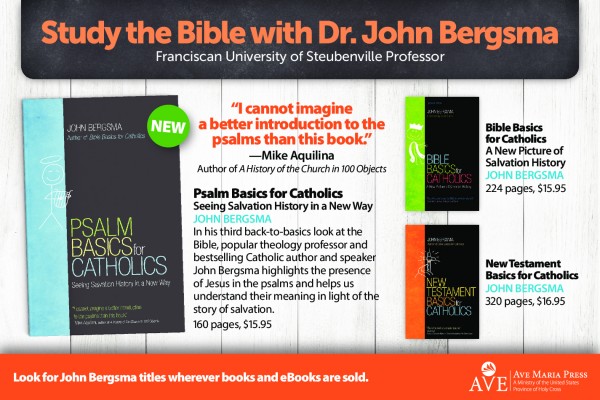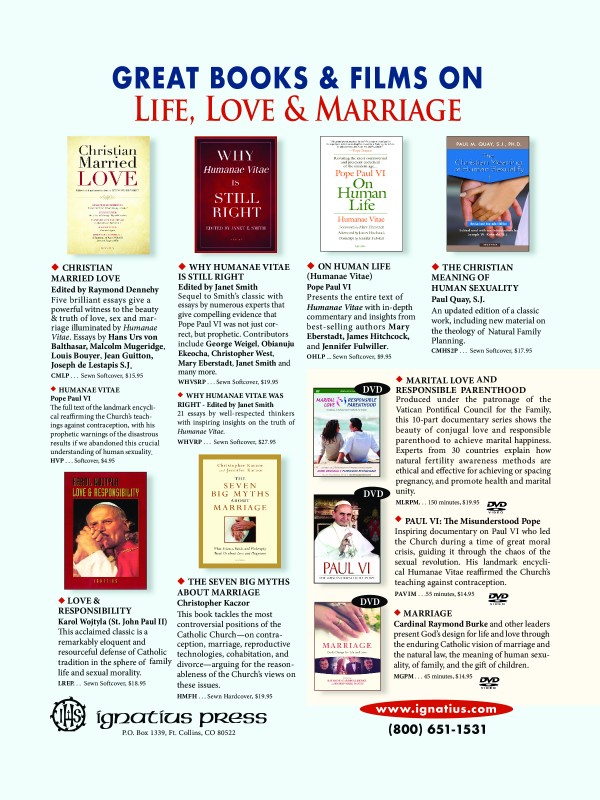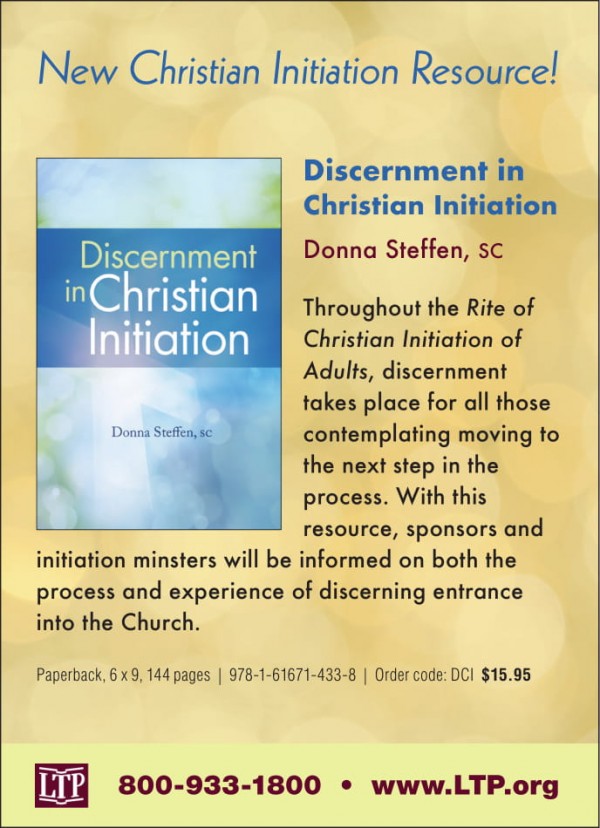AD: New Bible Study by John Bergsma
This is a paid advertisment. To order these books or others from Ave Maria Press click here or call (800) 282-1865, ext. 1.

AD: Great Books & Films on Life, Love & Marriage from Ignatius Press
This is a paid advertisement. To view more books from Ignatius Press click here, or call (800)651-1531.

The Spiritual Life: Unprofitable Servants and the Mystery of God’s Ways
God is always at work in the hearts of his children. When catechists become aware of the mystery of the Triune God at work in the hearts of the children we serve, we naturally respond with humility and a desire for greater obedience to God, the Master Catechist.
Sofia Cavalletti and Gianna Gobbi, cofounders of the Catechesis of the Good Shepherd knew how to bow before the mystery of God at work in children, as is evident from this quote they wrote in a letter to catechists in Canada:
"It happens that in being with children we will sense the presence of a force, mysterious and silent, which does not belong to us, and we will treasure it as an inestimable privilege to be granted at times to “see” it working within the child. As Elijah did on Mount Horeb when he heard the “tiny, whispering sound,” at moments like this we too will want to “cover our face” in beholding the presence of God" (1Kgs 19:13).[i]
If we fail to acknowledge the reality of this always-present mystery, we are tempted to rely on our own education, training, experience, or skills as catechists to produce something we can measure. Rather than bow in humble obedience before God’s mysterious ways, we may become frustrated at not being able to share all we know. An inordinate focus on our own successes or failures as catechists impedes our growth in humility, an essential virtue in our work.
AD: New Christian Initiation Resource on Discernment!
This is a paid advertisement in the July-September 2018 issue. Advertisements should not be viewed as endorsements from the publisher. To learn more about the resources offered from Liturgy Training Publications call 800-933-1800 or visit www.ltp.org.

AD: Pauline Books & Media—Books on Discernment, Saints and more
This is a paid advertisement in the July-September 2018 issue. Advertisements should not be viewed as endorsements from the publisher. To find out more about products from Pauline Books & Media call 800-878-4463 or visit www.PaulineStore.org
The Spiritual Life: The Offering of the Body
In Saint Paul's exhortation to the Romans, we read: "offer your bodies as a living sacrifice, holy and pleasing to God, your spiritual worship. Do not conform yourselves to this age . . . ." (Rom 12:1-2). To some, this may sound contradictory: "offer you bodies as . . . your spiritual worship." To those who think that the material and the spiritual are not only separate but completely separated categories, Saint Paul's exhortation makes no sense.
There are philosophies that presume the material and the spiritual (if there even is a spiritual reality) are completely separate. And there are religions that propose the material (if there even is a material reality) and the spiritual are completely separate categories. But Christianity is not one of those, neither philosophically nor religiously. Christianity believes in the Incarnation: that God, who is spirit (Jn 4:24), united himself to a material body:
In the beginning was the Word, and the Word was with God, and
the Word was God. . . . And the Word became flesh and dwelt
among us, full of grace and truth . . . . [Jn 1:1, 14. emphasis added]
In the Person of Jesus Christ above all, the spiritual and the material are united. And each human person, made in the image and likeness of God, is also a union of the spiritual and the material.
And so, if we "offer [our] bodies as a living sacrifice . . . to God", we indeed are worshipping spiritually. To do this, we must "not conform [our]selves to this age", Saint Paul goes on to exhort. That was true in his day, and it is true in ours.
Encountering God in Catechesis
n Weakness
People don’t brag about how weak they are. People want to think of themselves as confident, capable, self-sufficient... strong. I certainly don't recall being cheered on for how physically weak I was as a freshman in gym class! And if there had been an award for that, I certainly would have won. I couldn't bench press the bar. These are not the stories we celebrate or share with others—we love sharing the stories in which we were the heroes.
The paradox of the Christian faith is that when we are weak, God's greatness and his strength are made manifest. St. Paul begged the Lord to take away a thorn in his side, but the response was "My grace is sufficient for you, for power is made perfect in weakness” (2 Cor 12:9).
Over many years in ministry, I have been drawn to a deeper union with God on many occasions. Frequently, this comes through a powerful experience of my weakness.
The Spiritual Life: Saint Elizabeth of the Trinity and Contemplative Prayer, Part 2
Adoration: Losing Self, Finding Peace
This article is the second in a three part series on the spiritual mission of St. Elizabeth of the Trinity for our time. We are arguing that contemplation of the Triune God can heal the wounds of social alienation that so profoundly mark the experience of believers today and, more than this, offers a fullness of Christian living no other kind of prayer can match. In our last article, we distinguished St. Elizabeth’s confidence in presenting a contemplative approach to the Trinity in contradistinction to the tentativeness that often comes through the preaching of those who do not share a deep devotion to the Divine Persons. In this article, we will further explore St. Elizabeth’s devotion to the Trinity by reflecting on her understanding of adoration as an oblative reality characterized by peace and a distinctly Christian understanding of self-forgetfulness.
St. Elizabeth of the Trinity contemplates the Trinity as a mystery in which one can both “lose” and “forget” one’s own self. She does not explicitly refer to Christ’s observation that whoever loses his life for the sake of Christ will gain it forever (Mt 16:25). Yet she approaches the Divine Persons, asking for the grace to completely “lose” herself so that she might be established in peace, and sees the immensity of God as evoking self-forgetfulness and complete surrender to his love.
A severe spiritual trial during her novitiate helped forge this devotion. Her prioress and novice mistress, newly appointed thirty-one year old Mother Germaine, describes Saint Elizabeth struggling with “shadows of a dark night,” including “interior disturbances, spiritual pain, and strange phantoms.” Such an observation is entirely consistent with Carmelite tradition. In his commentary, Dark Night, St. John of the Cross argues that such testing is necessary to dispose the soul to perfect union with God, and even more, that this union is already being affected during the trials when he seems so absent. In Spiritual Canticle, St. John of the Cross makes even more explicit that this is a spiritual battle against the devil. Suffering the dark shadows of this spiritual trial in contemplative prayer, according to this wisdom, would prepare Saint Elizabeth for a profound and fruitful union with Christ, the Bridegroom.
The Spiritual Life: St. Elizabeth of the Trinity and Contemplative Prayer, Part 1
A Spiritual Mission for our Time
The Spiritual Life: Spiritual Aridity—The Path to Spiritual Maturity
The Second Vatican Council’s reminder of a “universal call to holiness” for all the baptized[1] has borne great fruit in the life of the Church. In her mission of evangelization and catechesis, the Church has gradually identified how the call to holiness takes on flesh even in the life of a catechist. In fact, over the last 25 years there has been an emerging discussion of an authentic “spirituality of the catechist” based on the vocation and mission of the catechist. This positive movement is reflected in the Church documents and, with ever-increasing and expanding frequency, in the publication of articles, books, and curricula for the formation and training of catechists.[2] Any treatment of the spirituality of the catechist inevitably includes a focus on the nature of personal prayer. Often highlighted subtopics include: The importance of daily personal prayer; the effectiveness of evangelization and catechesis hinging on the catechist’s personal relationship with Jesus Christ; concrete recommendations on how to develop and maintain one’s prayer life through participation in the sacramental life of the Church, as well as other spiritual practices and exercises. In my experience, catechists accept with seriousness and dedication the vocation and mission that the Church entrusts to them. They generally participate diligently in all of the abovementioned areas of personal prayer, and sincerely strive toward personal holiness. In my years of training catechists and members of the laity, including through spiritual direction, it is rare, however, that I encounter someone with a basic understanding of how the overall path to holiness concretely unfolds. Personal prayer, as well as Christian perfection, are often described today as a “journey,” a “path to holiness,” or in terms of “spiritual growth.” While these are certainly apt descriptions, such analogies remain vague in themselves without concrete details about the path to holiness and where it leads. Many of us have forgotten the specific stages of the spiritual life proposed by the Doctors of the Church and spiritual masters such as St. Thomas Aquinas, St. Teresa of Avila, St. John of the Cross, St. Catherine of Siena, and St. Ignatius (although not a Doctor of the Church). The classical “three ways” or “conversions” of the spiritual life, the Dark Night of the Soul, and the Rules for the Discernment of Spirits, are not generally known or taught to catechetical leaders, catechists, or the laity as a whole. As a result, the spiritual life or path of holiness appears to many as a nebulous, disjointed journey. The times I touch upon one dimension or another of the stages of the spiritual life in a teaching or a homily, inevitably at least a few catechists or parishioners share afterward that they have experienced the exact same struggles in prayer, and how helpful it is to have clarity in those areas. For this reason, it seems appropriate to deal briefly with a reality many of our lay faithful face during personal prayer: spiritual aridity, or more specifically, the Dark Night of Sense.


